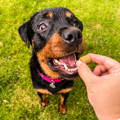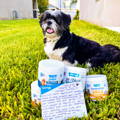7 Veterinarian Tips to Help Your Dog Lose Weight
Jump to Section

Our dogs love us no matter our size or shape, and we feel the same about them! But how will excess weight affect a pet’s long-term health?
As pet parents, we’re responsible for supporting our dogs’ physical and internal health. A so-called “healthy weight” will depend on multiple factors like size, age, and breed. Helping your pet maintain that optimal weight can not only extend their life but ensure your pet can keep up with every special memory you plan to make together!
So how can you help your dog lose weight? If you’re looking for the fastest way for your dog to lose weight, let’s rewind a bit––before tackling weight loss strategies, you’ll need to understand why dogs gain weight in the first place!
5 reasons why dogs gain weight
1. Poor Diet
Dogs who eat processed wet food (canned or pouched), dry food (kibble), or dog treats are likely missing out on essential nutrients that support overall health. Many processed kibbles and canned foods are calorically dense and heavy in nutritionally-lacking fillers, carbohydrates, and cholesterol, making weight gain more likely.
Medical conditions that cause weight gain in dogs
Hypothyroidism
Hypothyroidism is a medical condition that prevents a dog’s thyroid from producing sufficient thyroid hormones to maintain a healthy metabolism, leading to abnormal weight gain. Hypothyroidism in dogs is one of the more common glandular diseases affecting adult and senior pets and is a serious condition that should be discussed with your veterinarian.
Arthritis
Inflammation in the joints happens as your dog gets older, and may make specific movements uncomfortable–even painful–for your pet. If your dog experiences pain with movement, they may be less inclined to exercise which can lead to weight gain. Arthritis can affect dogs of any age but is more common in adult and senior dogs.

Which dog breeds are prone to weight gain?
For the most part, dog breeds prone to weight gain tend to be on the smaller side. Of course, that doesn’t mean your medium or large dog is exempt from the risks of obesity––lifestyle factors remain the biggest reason for weight gain in dogs.
Studies have shown that specific behaviors and characteristics make certain breeds more prone to weight gain. Risk factors can range from size to anatomy, and things like neutering and aging can increase these risks.
Arthritis–a risk factor for weight gain–can also disproportionately affect large to giant-size breeds and their mixes. Arthritis is also commonly seen in chondrodysplastic dogs, which are breeds (and their mixes) having unusual body conformation, with short or bent limbs and long vertebral columns (backbones). Chondrodysplasia is most common in pure bred dogs linked to dwarfism, such as Dachshunds.
Wondering where your dog’s breed weighs in? The top breeds prone to obesity are Beagles, Pugs, and Golden Retrievers, but they’re not alone on the list:
- Basset Hound
- Bernese Mountain Dog
- Boxer
- Bulldog
- Bullmastiff
- Cavalier King Charles Spaniel
- Chihuahua
- Cocker Spaniel
- English Springer Spaniel
- Jack Russell Terrier
- Labrador Retriever
- Pembroke Welsh Corgi
- Rottweiler
- Spanish Water Dog
7 vet-recommended ways to help dogs lose weight
You’re not the only pet parent wondering, “How can I help my dog lose weight?” It’s a common concern, and lots of people need advice––so how can you make it happen? More specifically, how can you reduce your dog’s weight at home?
Good habits start in the house, which is where your dog spends most of its time. Your dog’s healthy habits will rely on how well you set them up for success, and rewarding their good behavior won’t hurt, either! Just make sure you do it with healthy, appropriately-sized treats.

1. Determine portion size
What is the fastest way for a dog to lose weight? The first step would be determining their ideal portion size, while also maintaining portion control during meals. Figuring out your dog’s appropriate portion size will depend on their size: toy, small, medium, or large.
While there’s no official ‘formula’ for how much to feed your dog, you can start by consulting with your veterinarian to understand what your dog's ideal weight should be. Request the veterinarian calculate the dog's Resting Energy Requirement (RER) and advise the number of calories your dog should eat per day.
Once you know your dog’s daily calorie limit, reference the calories listed on the Nutritional Facts chart on each food and treat container you buy. From there, you can determine a daily portion that’s appropriate for maintaining your dog’s ideal weight!
2. Feed your dog nutritious food
What can I feed my overweight dog to lose weight? Start by cutting out ‘filler’ foods like commercially-available treats and processed foods. You’ll also want to limit the amount of 'people food' your dog consumes––unless it’s vegetables, fruit, or lean proteins.
Healthy dog food should have a balance of grains, vegetables, and fruit supplemented with lean proteins. These ingredients provide essential vitamins and minerals, as well as fiber which promotes better digestive health––another factor for maintaining a healthy weight. To ensure the best nutritional choices for your overweight dog, consider using only Veterinarians' best picks for a healthy dog food choice.
Water content found in whole foods like vegetables can also facilitate digestion and contribute to a sense of satiety (fullness), which should keep your dog fuller for longer.
3. Consider the breed
Is your dog on the list of breeds prone to weight gain? Make sure to feed only the portion recommended by your veterinarian, and make sure to provide level–instead of rounded–portions. Over time, consistently feeding smaller portions will promote a healthier weight.
4. Find an activity your dog loves
Does your dog seem uninterested or refuse to engage in certain activities? That could be an opportunity for you to discover a new activity more suited to their interests! Some dogs adore playing catch with a ball, while others might prefer exploring new hiking trails or playing at the beach. Once you find an activity they love, stick with it! You can also consult with your veterinarian to determine the safest, most appropriate activities for your dog to consistently participate.
5. Make exercise a daily practice
Dogs who are used to being lazy (sleeping a lot, staying indoors) might be harder to motivate but will benefit from exercise more than the average dog. Ideally, your dog should be getting a minimum of 30 minutes to two hours of activity every day.
6. Be active together
Pet parents, remember: Your dog will get their cues from you! If you spend more time outdoors walking or exercising, your dog will be more likely to emulate your good behavior. Daily walks or trail hikes are great ways for you both to get low-intensity exercise and fresh air.
7. Be conscious of treats
Whether you give your dog store-bought dog biscuits or smaller treats for training, these dietary additions can add up quickly! If you give your dog a daily health supplement, do it around meal time so that they won’t expect it between meals as a ‘snack’.
So, how long does it take for a dog to lose weight? The answer depends not only on the lifestyle changes listed above but the consistency of your combined efforts––and your dog’s age and overall health. If you’re not sure why your pet is gaining weight, discuss your concerns with your veterinarian and request guidance on food and treat portions, and ideas on activities that might be better suited to your dog’s unique needs!
Join the Pack!

Sign up for exclusive deals, curated pet tips from veterinarians, and product launches!
Pet Parents are Also Reading...
Mar, 2021
Related Articles























